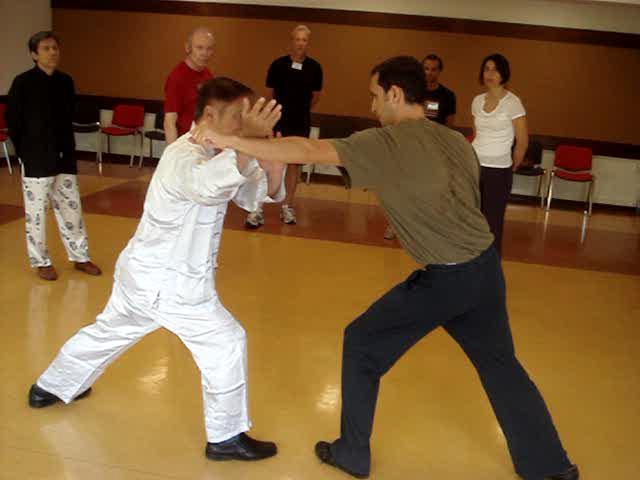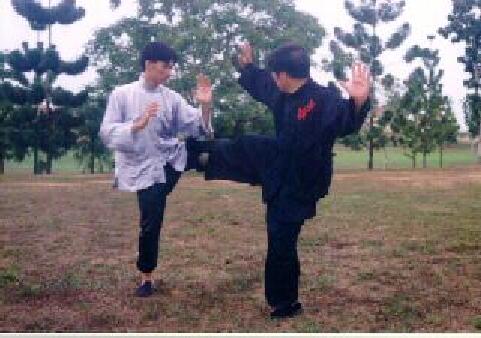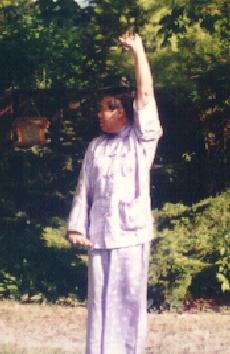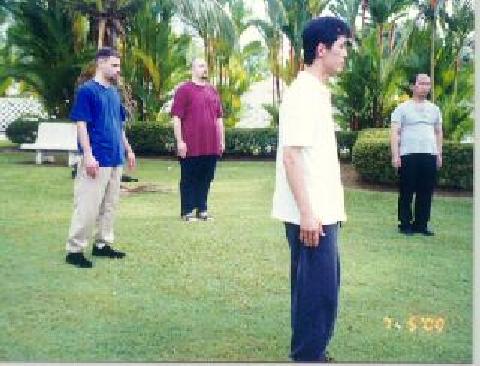February 2001 (Part 2)
SELECTION OF QUESTIONS AND ANSWERS

In Shaolin Wahnam, Taijiquan is always practiced as a martial art
Question 1
When I read your statement of the woman at one of your meetings arguing that she did not agree Taiji was a combat martial art, but an exercise, it sounded a lot like the teacher I had in a community center.
— Kris, USA
Answer
Most Taiji teachers at community centers treat Taiji as a gentle exercise, and would be shocked to learn that it is actually a martial art.
Their attitude is often due to the following situation which is common in Western societies. After learning some Taiji forms, and often before they themselves have understood the forms well, some people assume the responsibility upon themselves to teach others.
Community centers are frequently the places they teach, as there they can readily find students who learn for free and who join the classes more for socialization purposes. The teachers believe they are doing a great community service, little realizing they are debasing a great martial art into a dance.
Question 2
I love Tai Chi Chuan, and I would love to learn more. I only had the money to do one course. I often forget moves and have no template to work from. I learned the Yang style. I wanted to learn a form of martial art for heath benefits.
Answer
Practising genuine Taijiquan (Tai Chi Chuan) is very different from performing Taiji dance. Most people who perform Taiji dance at community centers, who expect fun and not hard work, and who usually do not want to pay high fees, cannot endure the demanding training of genuine Taijiquan even if a master were willing to teach them free.
If you or anyone really want to learn genuine Taijiquan, you must recognize and accept this fact. Practising genuine Taijiquan is never easy. “Never easy” means never easy. It means, among many other things, that if you often forget moves, you have to go over and over and over again the moves until you remember them spontaneously.
Many people may say they know what “never easy” means, but when they stand at their stance for only ten seconds when they are required to stand for fifteen minutes, or when perform their moves only once when they are told to perform fifty times, they do not know what “never easy” means.
Question 3
I had cancer and desperately needed something to make me feel better and more energetic. My fiancée told me that Taiji would be best for its soft flow. I agreed once I started. I want to continue my practices and learn more. What would be the best for me to begin?
Answer
Taiji dance may make you relaxed and elegant, but would not be powerful enough to make you more energetic and be free from cancer. If you wish to have these benefits, and more, you have to practise genuine Taijiquan from a genuine master. Nevertheless, in your case the best for you is to practise genuine chi kung from a genuine chi kung master who is willing to teach you.

Taijiquan is an internal martial art. Sifu Wong applies the Taijiquan pattern “Cross-Band Thrust Kick” to counter Chee Yong's sweeping kick.
Question 4
I would love to learn from a person who can teach me, where I can see him and he can correct my mistakes right there on the spot. But I don't have the money to take courses. I also live in a very small town that doesn't offer good courses. I want to learn the right way. Would I be able to visit websites or something to that affect and still learn efficiently?
Answer
Just because you want to learn, is no guarantee that a teacher may teach you, especially when you are not willing to pay his fees. You are like saying you want to own a beautiful, new car but you have no money, and you are asking where you can get the car. Genuine Taijiquan gives you more benefits than a beautiful, new car.
Despite what you said, you do not want to learn the right way. You want to learn the easiest way and at your best convenience. The right way is to learn from a genuine master — if he is willing to teach you. It is no surprise there are no masters in your town as genuine masters are very rare. You have to find them and go to them. Surely you cannot be so unreasonable as to expect a master to travel from his country to your doorstep to teach you for free.
You can learn a lot about Taijiquan from good websites, such as what genuine Taijiquan is and the importance of learning from a master. But you cannot be efficient in Taijiquan by merely visiting websites.
Question 5
I desperately want to continue my practices, but find it very frustrating when I can't remember a move or what is supposed to be next in the practice. I have not practiced very much lately and find my health deteriorating. I feel great when I am able to do Taiji, but when I get frustrated for forgetting a move or sequence, I tend to give up out of anger. Is there any advice you can give me?
Answer
Forgetting a move is not a big deal in genuine Taijiquan. There are many ways to overcome this problem. What you need is to learn from a living person, preferably a master but at least a competent instructor.
But most important you have to accept the fact that practising Taijiquan needs much time, effort and some sacrifice. This means you cannot be proficient in Taijiquan, or any art for that matter, by merely hoping to be proficient, or reading about it in a book or website, or expecting a teacher to teach you at your convenience.
When you practise genuine Taijiquan, you will have many rewards. Overcoming anger and frustration is only the beginning.
Question 6
I bought your books “The Art of Chi Kung” and “Chi Kung for Health and Vitality”. They are the best books I have read on Chi Kung, written in a manner and style which clearly reflects that you know and love your subject.
As I have not been able to find a competent chi kung master, I have compiled a simple routine that I practise every morning, to try and obtain some of the health benefits that consistent Chi Kung practice can offer.
Because of family history, I am susceptible to diabetes and arthritis. Prior to chi kung practice I had slightly higher than normal blood sugar and cholesterol levels and a lot of my joints ached. Now my blood sugar and cholesterol levels are normal and my joints don't ache as much. As my lifestyle has not changed much -- just no more sugar in my coffee, less butter and a glass of red wine every night -- I can only conclude that chi kung practice has contributed.
Now that I have discovered your website, I plan to attend your Intensive Chi Kung course in the future.
— Heng, Australia
Answer
I am glad of your progress in practising chi kung from my books. You will certainly get more wonderful benefits if you can learn personally from me, but if this is not feasible at present, carry on with your usual practise.
My books are written so that beginners can practise chi kung by following the instructions in them. Although the benefits are different from and understandably at a lower level than the benefits of those who learn from me personally, they are nevertheless more than good enough for most people who want good health and vitality.
It is important that you should leave aside those exercises which I have categorically stated must be practised under a master's supervision. This is only logical, yet it is amazing so many people ignore this simple advice, and, tacitly thinking themselves smarter than the master, not only attempt the advanced exercises despite the warning but even teach them to others, with the following two inevitable results — reducing advanced chi kung exercises into a dance, and sometimes causing adverse effects.
Your example is an inspiration to many people. You demonstrated that by following a simple routine and practising every morning, you could overcome two diseases, diabetes and arthritis, that even modern advanced medicine has difficulty overcoming.
I wish to emphasize two points. One, your routine is simple. You do not attempt advanced exercises but practise only the simple ones, those that many people mistakenly think are too simple or low for their effort.
The paradox, one not many people know, is that great masters have become what they are because they have practised very simple exercises. In my case, for example, the exercise I have practised the most, since my learning days till now, is “Lifting the Sky”, the very first exercise I teach to beginning students. Interestingly, this was also the first chi kung exercise my master Sifu Ho Fatt Nam taught me.
The second point is that you practise every morning. Many people do not practise, they only study chi kung, or they learn more and more techniques. And not many people practise regularly. Great masters have become what they are because they practise regularly. Without regular practise no one can get any commendable benefits from whatever art they pursue, be it chi kung, dancing or music.
As you progress in your practise, you can gradually increase your sugar intake. Your pancreas or other glands have become lazy due to prolonged period of your not taking sugar. You should add sugar a little a time to your coffee so as to stimulate your pancreas and other glands to resume their normal functions. Eventually you can take as much butter, wine and other good food as you like. Only when you don't have to control your diet, can you proudly say you are healthy and fit.

Sifu Wong demonstrating “Plucking Stars”
Question 7
A relative living in Singapore was diagnosed with pulmonary fibrosis. He is dependent on oxygen and any physical effort whatsoever is out of the question. As a result of the disease he is bed ridden and house bound.
Western medicine has no cure for pulmonary fibrosis. The medication he is receiving can, at best, only help in suppressing or retarding any further inflammation and damage. Will chi kung be able to cure him or at least alleviate the symptoms of the disease and his suffering?
Answer
From the chi kung perspective, there is no such a thing as an incurable disease. I believe pulmonary fibrosis can be overcome.
Western medicine and traditional Chinese medicine look at heath and illness differently. Let us say the causes of pulmonary fibrosis are x, y, and z.
From the Western medical perspective, because of x, y and z, your relative suffers from pulmonary fibrosis. Therefore, to cure him Western doctors have to find out what x, y and z are, and remove them from your relative's body. If they cannot find out what x, y and z are, they cannot effect a cure, and therefore have to be satisfied with relieving the symptoms.
From the traditional Chinese medical perspective, x, y and z do not directly cause the disease. They cause your relative's body to mal-function. In other words, because of x, y and z, your relative does not function the way he naturally does. The mal-functioning manifests in some symptoms, such as hardening of his lungs and difficulty in breathing. From these symptoms, Western doctors label your relative's disease as pulmonary fibrosis.
But Chinese physicians will not call it pulmonary fibrosis. What they call it depends on what parts of your relative's body cause the mal-functioning. For example, there may be insufficient flow of colon energy, or too much metabolism in the liver, or too much grief locked in his lung system. Hence, different persons suffering from what Western doctors would call pulmonary fibrosis, may be described differently by Chinese physicians.
Let us say your relative's disease is due to insufficient colon energy flow, and this was caused by factors x, y and z. One should also note that insufficient colon energy in your relative or in another patient can also be caused by other factors, such as a, b and c. But what the Chinese physician is interested in, is not x, y, z or a, b, c, but how to increase his colon energy flow. Once the colon energy flow in your relative is increased, he will regain his normal function and the disease called by Western doctors as pulmonary fibrosis will disappear.
Your relative can overcome his problem by practising chi kung or undergoing chi kung therapy. As he is bed-ridden, it is not convenient for him to practise chi kung. A better alternative is to undergo chi kung therapy. Fortunately for your relative, there is a very good chi kung therapist in Singapore. He is Sifu Chin Chee Ching. His address is Bk 124, 10-187 Rivervale Drive, Singapore 540124. His telephone numbers are 65-3846713, 65-98303325. You or your relative should contact Sifu Chin as soon as possible.
Question 8
I took Tang Lang (Praying Mantis) when I was a child. Along the way, I have studied Judo, Karate and Taekwondo. I was thrilled when I learned that a Shaolin school had opened at my place. I visited and what I saw confused me, and I hope you can help.
The school teaches what is called Shaolin-Do but they teach katas like in Karate, wear karate uniforms, their tests use the Karate/Judo system of belts but they say the forms they teach are Shaolin forms. What is your opinion of this? Is Shaolin-Do an authentic form of Shaolin Kung Fu?
— Harry, USA
Answer
Shaolin-do is not an authentic form of Shaolin Kungfu. I think the Shaolin-do school teaches karate, but uses the name “Shaolin” for publicity.
The term “do” is typically Japanese. Examples of “do” martial arts are karate-do, judo, kendo and aikido. Korean martial arts are also suffixed with “do”, such as taekwondo, hapkido and tangsoodo.
“Do” is in Japanese, and in the Korean language. The word in Chinese is “dao” (pronounced and also spelt as “tao”), which means “the way”. Karate-do is therefore “the way of karate” or “the way of empty handed combat”, and judo is “the way of ju” or “the way of softness”.
What the Japanese and Koreans call “do”, the Chinese would call “quan”, which literally means “fist”, but figuratively means “martial art”. Some examples are Shaolinquan, Taijiquan, Baguaquan, Xingyiquan, Tanglangquan, Hungjiaquan, and Faquan.
“Quan” is the shortened form for “quan-fa”, or “the techniques of the fist”, and the Japanese pronunciation of the same words is “ken-po”. Hence Shaolin Kungfu is “Shaolinquan” in Chinese, and “Shaolinji Kenpo” in Japanese.
The forms as well as philosophy of Shaolin Kungfu and of karate are characteristically different. While karate mainly employs the clenched fist and sometimes the palm chop, Shaolin Kungfu employs a great variety of hand forms, such as tiger-claw, eagle-claw, dragon-form, phoenix-eye, praying mantis hook, monkey paw, crane beak, tiger-claw palm, dragon palm, snake palm, and one-finger Zen.
Karate training is mainly external, and its power is derived from mechanical means like speed and muscles. Shaolin Kungfu emphasizes on internal training, and its internal force is derived from non-physical factors like energy flow and mind. The combat philosophy of karate is to win at whatever cost, whereas in Shaolin Kungfu winning is not so important, what is the most important is to come out of combat unhurt.
Shaolin Kungfu exponents do not wear karate uniforms, and there is no belt grading system.

Students enjoying a chi flow at an Intensive Chi Kung Course in Malaysia
Question 9
Thank you for writing a wonderful book on Chi Kung practice. I have been introduced to a few other forms of Chi Kung exercises in different classes, but I have never had such a clear explanation of the underlying principles and goals of practice.
But I am a little unclear about how to coordinate the breathing and hand movements in the Plucking Stars exercise. Could you please give me some clarification?
After you hold the ball of chi in front of you and begin breathing in, do you begin raising your arms while breathing in, and then complete the breathing in as the arms are fully extended? Or do you visualize and breathe in completely, pause, and then raise the arms? In other words do you move and breathe and visualize all at the same time, or do you separate the breathing and visualizing from the movement?
In the same way, as you breathe out, do you hold your hands in the extended position until the out-breath is complete and then move your hands, or are your hands moving back to the starting position as you breathe out?
Also, as you visualize the energy flowing to your hands, I am a little confused about where to visualize it flowing from? (“visualize energy flowing to your two hands” p.26?) Is it internal vital energy from the abdomen, or is it external energy from the cosmos?
If I take a Chi Kung Intensive Course, is it possible to stay for a further 3-4 days for more personal, or private session of Chi Kung? I am a doctor of Internal Medicine and have been doing yoga for several years, and also practice Chi Kung and have all of Sifu's books. I think there is a very great need for more people to get to a master level of Chi Kung and teach others.
— Alan, USA
Answer
Yes, you are welcome to stay back to seek further information or personal supervision from me after the intensive chi kung course.
The course is complete by itself, i.e. one does not need prior experience nor further session, and he will be competent to practise on his own to attain a fairly high level.
Many people, including some who have taught chi kung before, have told me that they are amazed at what they have learnt and benefitted from the course. The onus of the course is not learning more techniques — if it were techniques that they were after, they needed not attend my course, they would have learnt more from my books or other books; the onus is on developing fundamental skills.
The skills you will develop include attaining a one-pointed mind, going into a deeper level of consciousness, tapping energy from the cosmos, generating an internal energy flow, and directing the energy to wherever part of your body you wish.
Actually these skills are fundamental in any chi kung, and a student would learn at least some of them, especially attaining a one-pointed mind and generating energy flow, at the beginning stage of his chi kung career. Without these fundamental skills it would be difficult for any student to progress in real chi kung development. In many years, much of subsequent development is deepening of these skills.
“Beginning stage” refers not to the time a student spends on his training, but the stage of his development. Depending on various factors like the type of chi kung he practises and the methodology of his teacher, it may range from a few days to a few years. If he practises a low level type of chi kung and his teacher is conservative, a student may need to train for a few years before he can attain a one-pointed mind and generate energy flow.
Regarding my three-day intensive course as a complete programme, the first session on the first day of training is the beginning stage, and the last session on the third day the advanced stage. Hence, fundamental skills like attaining a one-pointed mind and generating energy flow are acquired in the first session.
In the remaining sessions, which constitute the intermediate stage, students consolidate these fundamental skills and learn other useful skills like developing internal force and clearing energy blockage with self-manifested chi flow. It would be difficult, if not impossible, to develop internal force or clear energy blockage if in the first place the students cannot attain a one-pointed mind or generate energy flow.
There is no “learning” at the advanced stage. Here students practise on their own as if I were not present — although I would be standing at the back observing them intensely — to confirm that they can competently continue their practice at home.
On the other hand, regarding your chi kung career as a whole, attaining my intensive course is only the beginning stage. The intermediate stage will comprise deepening the skills you have learnt in the intensive course as well as acquiring other useful chi kung skills. This stage may range from about two to twenty years, depending on various factors. At the advanced stage, you consolidate your skills and become a genuine chi kung master, who is, as you have rightly suggested, very rare today and much needed in our modern world.
With this background understanding of my intensive chi kung course, you would realize that it is not necessary for you to stay back for a few days to take another private course from me. Nevertheless, there may be questions you would like to discuss with me, or skills and techniques you may like me to review and comment. I shall gladly do these after the course, and you do not have to pay me for it.
It is evident from your e-mail that you are sincere in wanting to be a master and helping others, and as a doctor of internal medicine you are distinguishably suitable. I hope you may one day rewardingly employ chi kung to help your patients, or if you qualify and if you are interested, teach chi kung in the name of Shaolin Wahnam.
At the course you will learn the techniques of "Lifting the Sky", "Pushing Mountain" and "Carring the Moon", and various skills. You will be able to practice "Plucking Stars", as well as any chi kung technique well.
